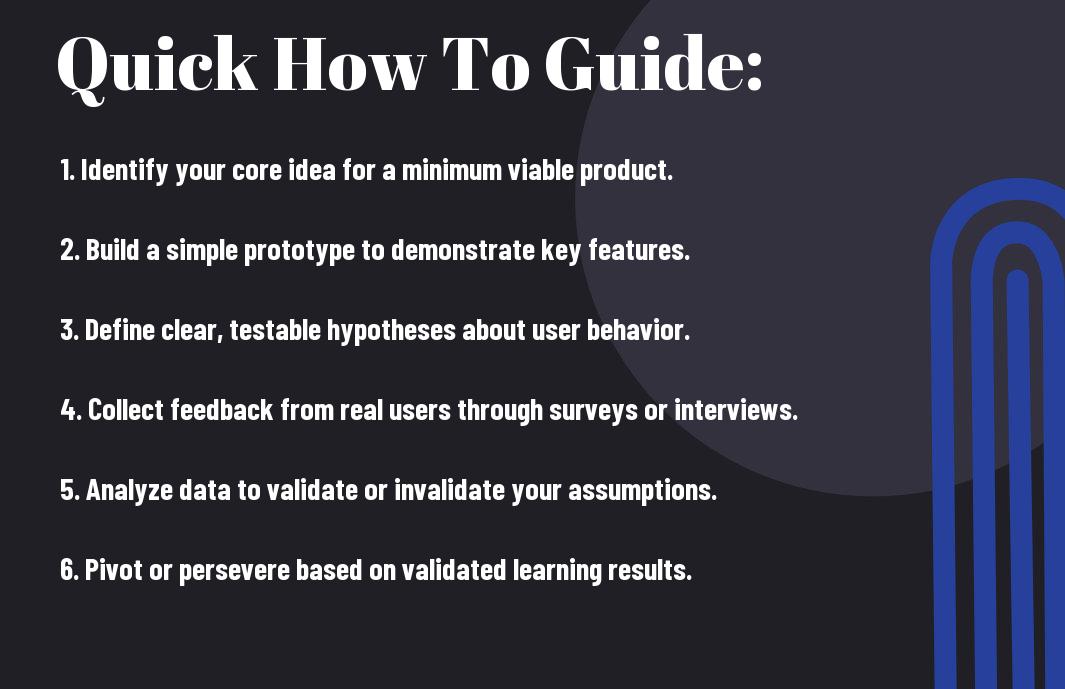
Startup success hinges on my ability to validate ideas before diving headfirst into development. The Lean Startup Method offers a systematic approach to test your ideas quickly and efficiently, ensuring you invest your resources wisely. In this post, I’ll share key strategies to help you gather valuable insights from potential customers, allowing you to pivot or persevere based on real feedback. By the end, you’ll be equipped with the tools to identify what resonates with your audience and avoid the dangers of launching an untested concept.

Key Takeaways:
- Emphasize the importance of validated learning by continuously testing ideas and hypotheses in real-world scenarios.
- Utilize minimum viable products (MVP) to gather feedback quickly and effectively, allowing entrepreneurs to iterate on their products.
- Incorporate a build-measure-learn feedback loop to optimize processes, reduce waste, and pivot as necessary based on user feedback.
- Focus on actionable metrics over vanity metrics to ensure that data collected drives meaningful insights and decision-making.
- Encourage a culture of experimentation and adaptability, enabling teams to embrace uncertainty and make informed, data-driven decisions.

Understanding the Lean Startup Method
For anyone looking to innovate in the business world, the Lean Startup Method presents a pathway to effectively test your ideas before fully launching. This approach emphasizes rapid experimentation and customer feedback, providing a practical framework for entrepreneurs of all levels.
Definition of the Lean Startup Method
With the Lean Startup Method, I focus on building a minimum viable product (MVP) quickly to incorporate user feedback, enabling a more iterative and efficient development process. This allows for timely pivots and adjustments based on real market needs.
Importance of Validated Learning
Lean Startup introduces the concept of validated learning, which underscores the importance of basing your decisions on actual data rather than assumptions. This process ensures that I gauge my product’s viability through genuine customer interactions and insights.
Lean Startup emphasizes validated learning as an important mechanism for understanding what works and what doesn’t in your business model. By testing assumptions, you mitigate the risk of large-scale failures and increase your chances of developing a product that resonates with your target audience. It empowers you to act on real evidence, leading to smarter, data-driven decisions.
Core Principles of Lean Startup
Methodologically, the Lean Startup is guided by principles such as building, measuring, and learning. These cycles repeat, ensuring that I’m continually refining my product based on direct feedback, which helps in avoiding wasted resources.
Methodically applying the core principles of Lean Startup means that I continually seek to enhance my product’s value proposition while minimizing waste. This iterative process allows for fluid transitions between development stages and fosters a culture of innovation and adaptability. By focusing on user feedback, I align my business objectives more closely with market demands.
Validated learning plays a key role in ensuring that the path I choose is informed, minimizing the risks associated with launching a product that may not meet customer expectations. By prioritizing data and feedback, I can confidently transform my vision into a reality that serves the market effectively.

Identifying Your Business Idea
Some entrepreneurs struggle with identifying a business idea that resonates with them and their potential customers. This chapter will help you navigate the process of uncovering viable ideas by providing useful strategies and considerations.
Generating Ideas: Tips for Innovation
While brainstorming can seem daunting, I find that embracing creativity is important. Consider the following tips to spark innovation:
- Draw inspiration from personal passions
- Identify problems in everyday life
- Analyze competitors’ offerings
- Engage in collaborative brainstorming sessions
- Utilize online idea generators
After experimenting with these techniques, you might uncover a potential business idea that excites you.
Importance of Market Research
For any business idea to gain traction, market research is important. It allows you to understand the needs and preferences of your target audience, analyze your competition, and identify potential niches in the market.
Plus, conducting thorough market research equips you with valuable data that supports your decision-making process. It helps validate your ideas, reducing the risk associated with launching your product or service. You’ll learn about customer behaviors, trends, and industry dynamics that can guide your strategy and ultimately lead to success.
Factors to Consider in Your Idea Selection
There’s a multitude of factors that influence your idea selection. Pay attention to the following:
- Feasibility of execution
- Potential profitability
- Your passion and expertise
- Market demand
- Growth potential
Assume that you weigh these components carefully, as they can significantly affect your business’s success and sustainability.
Innovation is about matching your strengths with market needs. By examining the factors mentioned above, you can analyze what truly aligns with your vision and market dynamics. It’s important to be mindful of the risks and opportunities presented by each potential idea, allowing you to make informed choices. Factors such as cost and time requirements can greatly influence your decision-making process. Assume that you select an idea that not only excites you but also stands a strong chance in the market.
Building a Minimum Viable Product (MVP)
Keep in mind that creating a Minimum Viable Product (MVP) is a vital step towards validating your business idea. It is a simple version of your product with just enough features to attract early adopters and gather valuable feedback. The MVP allows you to test assumptions and learn what your customers truly need without investing too much time or resources at this stage.
What is a Minimum Viable Product?
Now, an MVP is not about building a perfect product but rather a functional one that meets the most imperative needs of your target audience. It’s about finding the right balance between underdevelopment and overdevelopment. Your goal is to create a solution that you can build, test, and iterate upon based on real user feedback.
Steps to Create an Effective MVP
To create an effective MVP, start by identifying your core idea and defining the problem it solves. You’ll want to prioritize features based on customer value, focusing on what is absolutely necessary for your users. Next, develop a prototype that reflects these core features and prepare to test it with early adopters.
Understanding the steps to create an effective MVP involves thorough research and customer validation throughout your development process. First, conduct surveys or interviews to understand your audience’s real needs. Then, create user personas to guide your product development. Use wireframes and prototypes to visualize your ideas, allowing you to iterate quickly before full-scale development. Finally, collect feedback from testers to refine your product before a wider launch.
Best Practices for MVP Development
Minimum viable product development should focus on simplicity and speed. Test your ideas quickly and avoid overcomplicating features that aren’t imperative for your core offering. Keep your team aligned, maintain clear goals, and be prepared to pivot based on user feedback. Engaging your audience during this phase is imperative to ensure you address their needs effectively.
Development of your MVP should embrace an iterative approach that allows you to make adjustments based on honest feedback. Establish a feedback loop with your initial users to refine product features continuously. Also, be open to unexpected insights – these can often lead to greater product refinement or even pivoting your idea altogether. This adaptability is one of the key strengths of the Lean Startup method.
Testing Your Ideas
Your ideas can only thrive if they resonate with your target audience. By testing them early and frequently, you can affirm their viability and make informed adjustments. The Lean Startup method provides a framework to help you gather real-world feedback efficiently, which is imperative before committing significant resources to a full launch.
How to Conduct Effective Market Tests
Ideas can take many forms, but when it comes to market testing, a focused approach is key. Start by identifying your target audience and design simple experiments that allow potential customers to engage with your concepts. This could involve offering a basic prototype, a landing page, or a survey to gauge interest and collect key insights on their preferences.
Gathering Feedback: Methods and Tools
You can employ various methods and tools to gather valuable feedback. Utilizing online surveys, social media polls, and direct interviews can unveil deeper insights. Additionally, wireframes and minimum viable products (MVPs) allow people to interact with your offerings, giving you quantitative and qualitative data imperative for your decision-making process.
It’s important to select the right mix of tools to suit your specific needs. Using software like Typeform for surveys or Google Analytics for website performance can provide the quantitative data you need, while tools like UserTesting offer qualitative insights through user experiences. These resources help to ensure you’re making informed choices based on direct customer input.
Analyzing Test Results for Insights
You must analyze the results from your tests to extract key insights. Look for patterns and commonalities in the feedback that can indicate what resonates well with your audience. This process will guide your next steps and inform necessary adjustments to your ideas before a larger launch.
Effective analysis requires both quantitative and qualitative measures. By synthesizing this data, you’ll identify which elements of your concept work and which need refinement. This insight not only minimizes risk but enhances your product’s potential for success by allowing you to iterate and pivot based on concrete evidence of your market’s preferences.
Iterating Based on Feedback
To effectively refine your startup idea, you must embrace the power of iteration based on user feedback. This process requires you to be adaptive and receptive to input from your target audience. By systematically integrating their insights, I can enhance the product’s functionality, usability, and overall appeal.
Understanding the Iteration Process
If you want to succeed, understanding the iteration process is important. This method involves developing a minimum viable product (MVP), gathering feedback, and making adjustments. By repeating this cycle, I can gradually improve the product and ensure that I focus on what truly matters to my users.
Tips for Making Data-Driven Decisions
If you rely on data for your decisions, I have some tips that might help. Leverage tools for user analytics, conduct surveys, and analyze behavior patterns. Data should guide the direction of your iterations.
- User Analytics
- Surveys
- Behavior Patterns
Assume that by consistently adopting these tips, your product can evolve in harmony with user expectations.
Iteration relies on making data-driven decisions that reflect real user experiences and needs. Integrating qualitative and quantitative data will provide a holistic view of how to shape your product. Furthermore, don’t underestimate the importance of engaging directly with your users to gain deeper insights into their preferences and pain points.
- Qualitative Data
- Quantitative Data
- User Engagement
Assume that this combination will significantly enhance your ability to cater to your audience’s desires and needs.
Factors Affecting Successful Iteration
Iteration is influenced by various factors that can either facilitate or hinder your progress. I must consider key elements like team dynamics, user engagement, and feedback quality. Paying attention to these factors can significantly elevate the effectiveness of my iterations.
- Team Dynamics
- User Engagement
- Feedback Quality
Knowing how these factors interplay can empower you to create a more resilient startup.
Assuming you investigate deeper into these factors, you will find that successful iteration requires an open mindset and a collaborative environment. Consistently fostering strong team dynamics allows for better communication and more efficient feedback integration. Prioritizing user engagement builds trust, while focusing on feedback quality facilitates meaningful changes.
- Open Mindset
- Collaborative Environment
- Trust Building
Knowing that these elements are interconnected will enhance the overall efficacy of your iteration processes.
Based on the above insights, I urge you to approach iteration as a continuous learning journey. Utilize constructive feedback, make data-driven decisions, and be mindful of the factors affecting your success. By embracing this cycle, you will not only enhance your product but also position your startup for sustainable growth.
Scaling Your Idea
Unlike the early phases of your startup journey, scaling your idea requires a strategic approach that focuses on growth and sustainability. Once you’ve validated your concept through minimum viable products (MVPs), it’s time to consider how to transition into a broader market while maintaining the integrity of your vision.
When to Transition from MVP to Full Launch
On your path to scaling, it’s vital to recognize the right moment to transition from MVP to a full launch. You should consider launching when you have gathered sufficient customer feedback, demonstrated consistent product-market fit, and can meet the demand evidenced by your early adopter base.
Strategies for Scaling Effectively
With a solid foundation in place, I recommend implementing a series of strategies that focus on both growth and operational efficiency. These strategies could include expanding your marketing efforts, enhancing customer service, and optimizing your supply chain.
Effectively scaling your startup involves leveraging data analytics to identify trends, automating operational processes to boost efficiency, and fostering partnerships that can enhance your distribution channels. Adaptive marketing tactics such as targeted campaigns and social media outreach can also help to broaden your audience, while continuously seeking customer feedback ensures that you stay aligned with market needs as you grow.
Potential Challenges During Scaling
One of the significant challenges you may face during scaling is maintaining quality control as you increase production or service capacity. Ensuring that your new team members are trained effectively and that your operational processes scale alongside your customer base is vital.
The reality is that as you scale, the risk of losing the essence of your brand or encountering operational inefficiencies increases. You might struggle with balancing rapid expansion while ensuring that your value proposition stays strong. It’s critical to focus on refining processes and keeping an open line of communication with your team and customers to navigate these potential roadblocks effectively.
To wrap up
Drawing together the principles of the Lean Startup Method, I find that testing ideas before launching is an effective strategy for entrepreneurs. By utilizing validated learning, I can minimize risks and avoid common pitfalls. As you engage in iterative prototyping and feedback loops, you enhance your understanding of your target market. This approach not only saves time and resources but also fosters a culture of adaptability in your business. Ultimately, I believe that embracing these principles can significantly increase your chances of building a successful and sustainable startup.
FAQ
Q: What is the Lean Startup Method and how does it help entrepreneurs test their ideas?
A: The Lean Startup Method is an innovative approach to developing products and businesses that emphasizes rapid prototyping, validated learning, and iterative product releases. This method allows entrepreneurs to create a minimal viable product (MVP) that can be tested in the market with real users. By gathering feedback and measuring user reactions, entrepreneurs can quickly learn what works and what doesn’t, making informed decisions about the future of their product without investing substantial resources upfront.
Q: How can I create a minimal viable product (MVP) using the Lean Startup Method?
A: Creating an MVP involves identifying your core product features that solve a specific problem for your target audience. Start by defining your value proposition and the necessary functionalities that address user needs. Then, develop a simplified version of your product that can be released to a small group of early adopters. Share it with them for feedback, observe how they interact with it, and use their insights to refine your offering. This iterative process enables you to develop a product that users genuinely want, thereby increasing your chances of success when launching.
Q: What are some common pitfalls entrepreneurs face when using the Lean Startup Method?
A: Some common challenges include focusing too much on perfection instead of launching a basic version of the product. Entrepreneurs might also neglect to gather sufficient feedback from users, leading to assumptions that may not reflect the market’s needs. Additionally, losing sight of the data collected during testing and not pivoting based on validated learning can hinder growth. To avoid these pitfalls, maintain an agile mindset, prioritize feedback, and be willing to adjust your approach based on the insights gained throughout the testing process.
Leave a Reply